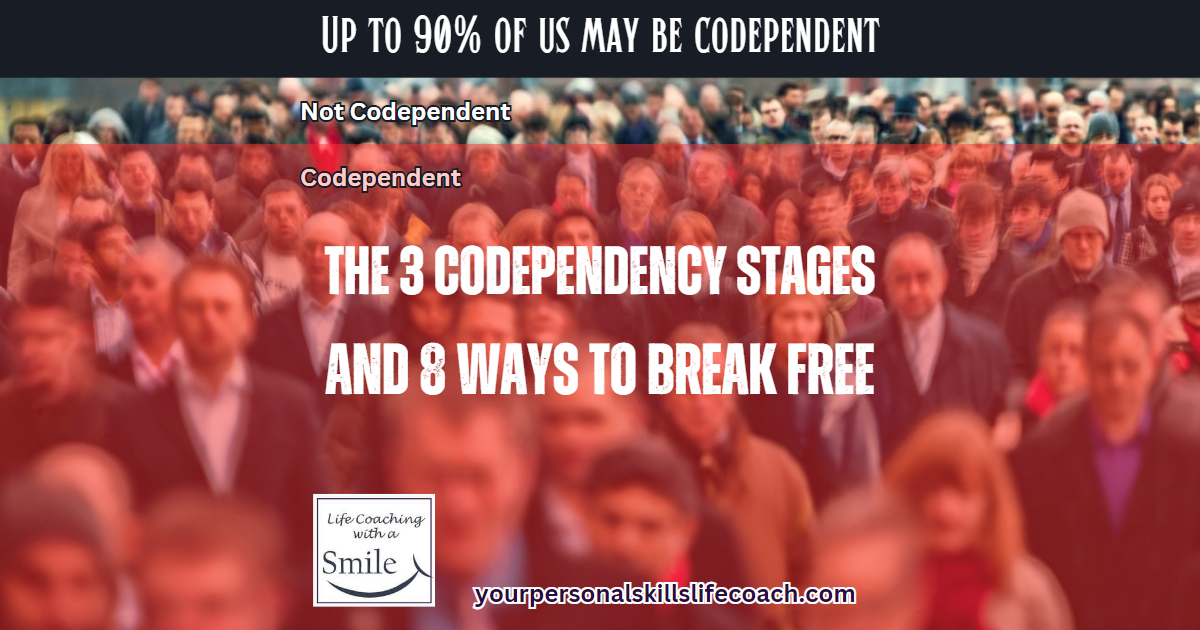We see the term “codependent” so frequently in publications and self-help articles we might wonder how prevalent codependency is. The truth is hard to pin down. Some estimates suggest 80-90 percent of the American population demonstrates some codependent behavior. We all need to know the 3 Codependency Stages & 8 Ways to Break Free.
Preface to The 3 Codependency Stages
& 8 Ways to Break Free
Specific measures of codependency are hard to determine. Experts introduced the term “codependency” in the 1940s to help describe behavior patterns of families of alcoholics. But even now, some 70 years later, there is still much disagreement as to what codependency actually encompasses. Codependency is not a clinical diagnosis nor is it a personality disorder. It has become the catch-all name for any enabling relationship.
Research tells us codependency is a behavior usually learned during childhood. It develops while growing up in a dysfunctional family. In a dysfunctional family, members suffer from pain, anger, fear or shame as we all do. But the dysfunctional family do not address or confront the issues. As a result, emotions are repressed and needs are disregarded. Children growing up in such a family do what children do, imprinting the behavior watching and imitating the dysfunctional family members who display codependent behaviors.
What is Codependency?
Essentially, codependency is the term used for an imbalanced relationship. In other words, the term codependency describes a relationship where one person supports another person and provides a giver function. The other person is the taker, reliant on the partner.
These relationships do not have to be romantic. They can be friend or family relationships. They can become addictive, dysfunctional and difficult to leave. There may be manipulation, emotional and physical abuse or substance abuse.
The Taker and the Giver
The co-dependent taker demonstrates a combination of childish, selfish or troubled behaviors. This individual will often sandbag their abilities and may be needy on an emotional level. They depend on the giver in the relationship to take care of everything. The codependent giver becomes a rescuer. They show love and care, but they sacrifice their own needs. Both the giver and the taker can become addicted to their codependent behavior.
Now that you understand what codependency is and how it works. we can discuss the 3 codependency stages & 8 ways to break free.
The 3 Codependency Stages
Codependency typically progresses in predictable stages.
Stage 1
In the beginning, the giver becomes obsessed with someone and may even give up their own friends or put all their enjoyable pastimes to one side to spend more time with that person that “needs them.”
Stage 2
Codependent giver invests more and more time and likely does not receive much connection or commitment in return. Subconsciously the giver hopes the taker will see and respond to the giver’s love. The giver hopes the taker will change as a result of their love and sacrifice. This thinking is destructive. More often, the giver becomes frustrated and disappointed.
Stage 3
Giver can develop health related issues, headaches, muscle pain, sleeplessness, and stress. Self-esteem is extremely low, likely to feel angry or hopeless. Hygiene, outside interests, and well-being may suffer or disappear as the giver’s anger grows.
8 Ways to Break Free
Are you constantly making excuses for things that he or she does? Do you hide the things that your partner does from your friends because you know that they would tell you to get the heck out of there if they knew?
If you suspect you are in a codependent relationship, there are things you can do to free yourself.
- Bolster your support network. There are 12 step programs, friends and family. Create a new network of healthy contacts.
- Learn more about codependency. The world library is at your fingertips. The experts are Pia Mellody and Melody Beattie.
- You need to know yourself. Address the origins of your behaviors, beliefs, and patterns that formed into working models of codependency.
- Ask yourself what you want. Find out who you are outside of your relationships. It can help you get clarity.
- Set boundaries (if safe.) Once you know what you want, say no to anything outside of that.
- Find an interest of your own.
- Grab a pen. Journaling is part of the process. Start with an affirmation.
- Seek Therapy


Help for Codependent Friend or Family Member
Your friend has to choose to leave the relationship on his or her own. Nevertheless, you can take the following steps support your friend. You can support them without endorsing the harmful relationship.
- Help with self-worth. Build up your friend’s self-worth, so they get some validation from an outside source.
- Provide a safe space. Reassure your friend that they can confide in you.
- Don’t judge. Remain open to listening even if you don’t understand. Help them realize the problem themselves.
The 3 Codependency Stages & 8 Ways to Break Free: Focus on You
Before you can begin to explore how to fix a codependent relationship, or how to help a friend, you need to understand completely where the codependency or over-dependence in the relationship comes from. Whether you work with a professional (therapist or coach) or take an introspective journey by yourself, finding out the origins of your codependency will help you. Then you can begin to take steps to focus less on someone else and focus on you.
Related Articles:

